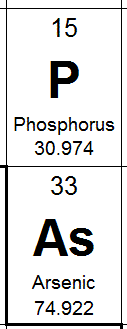
News of surprising biochemistry: Thriving on Arsenic (NASA Astrobiology Magazine)
NASA microbiologist Felisa Wolfe-Simon has discovered bacteria that apparently can use arsenic in its DNA in place of phosphorus. Most biochemistry can be done with six elements: carbon, hydrogen, oxygen, nitrogen, phosphorus, and sulfur (CHONPS). Smaller amounts of a variety of other elements are also necessary to varying degrees depending on the organism, such as sodium, calcium, iron, and magnesium. Arsenic is similar enough to phosphorus (same column in the periodic table, Figure 1) that within these bacteria it may be able to play the same role.
From the Astrobiology Magazine article:
The recent discovery by Felisa Wolfe-Simon of an organism that can utilize arsenic in place of phosphorus, however, has demonstrated that life is still capable of surprising us in fundamental ways. The results of her research were published December 2 on Science Express and subsequently in the journal Science.
The organism in question is a bacterium, GFAJ-1, cultured by Wolfe-Simon from sediments she and her colleagues collected along the shore of Mono Lake, California. Mono Lake is hypersaline and highly alkaline. It also has one of the highest natural concentrations of arsenic in the world.
On the tree of life, according to the results of 16S rRNA sequencing, the rod-shaped GFAJ-1 nestles in among other salt-loving bacteria in the genus Halomonas. Many of these bacteria are known to be able to tolerate high levels of arsenic.
But Wolfe-Simon found that GFAJ-1 can go a step further. When starved of phosphorus, it can instead incorporate arsenic into its DNA, and continue growing as though nothing remarkable had happened.
“So far we’ve showed that it can do it in DNA, but it looks like it can do it in a whole lot of other biomolecules” as well, says Wolfe-Simon, a NASA research fellow in residence at the USGS in Menlo Park, California.
The article describes the methods used to purify the DNA, to ensure that the arsenic was truly incorporated into the structure of the DNA rather that being associated with other molecules. Not all, however, are convinced.
But Steven Benner, a distinguished fellow at the Foundation for Applied Molecular Evolution in Gainesville, FL, remains skeptical. If you “replace all the phosphates by arsenates,” in the backbone of DNA, he says, “every bond in that chain is going to hydrolyze [react with water and fall apart] with a half-life on the order of minutes, say 10 minutes.” So “if there is an arsenate equivalent of DNA in that bug, it has to be seriously stabilized” by some as-yet-unknown mechanism.
Benner suggests that perhaps the trace contaminants in the growth medium Wolf-Simon uses in her lab cultures are sufficient to supply the phosphorus needed for the cells’ DNA. He thinks it’s more likely that arsenic is being used elsewhere in the cells, in lipids for example. “Arsenate in lipids would be stable,” he says, and would “not fall apart in water.” What appears in Wolfe-Simon’s gel-purified extraction to be arsenate DNA, he says, may actually be DNA containing a standard phosphate-based backbone, but with arsenate associated with it in some unidentified way.
Microbiologists over the past few decades have discovered bacteria and archaea in increasingly hostile places, such as hot springs and deep in Earth’s crust. This has spurred on the hope that other worlds (e.g. Mars, Titan) also have places that would be suitable for bacterial life. The possibility of bacteria that can live with a chemical foundation other than CHONPS indicates that life might thrive in places where we otherwise would not have expected it to.
This discovery may not completely redefine life as we know it, but it does (if proven to be true) add one more bizarre thing that life can do.
Grace and Peace

Classical science, has yet to discover the full spectrum of DNA imprinting function or the direct connection between DNA and consciousness.
Consciousness is a form of electromagnetic energy!
The primary function of our DNA is not protein synthesis, as biologists will tell you , but the reception and transfer of electromagnetic energy.
Our DNA is capable of producing and receiving sound (phonons) and light (photons) The DNA is a kind of a lens which can attract electromagnetic energy into itself. Every biochemical reaction is preceded by an electromagnetic signal.
Life is fundamentally electromagnetic than biochemical, the DNA blueprint functioning as a bio hologram which serves as a guiding matrix for organizing physical form.
DNA can be influenced by acoustic, electromagnetic and SCALAR WAVES.
CAPT AJIT VADAKAYIL
..
LikeLike
Cuckoo! Cuckoo!
Though, I have to admit some of the nonsense there is pretty funny.
“DNA can be influenced by acoustic, electromagnetic and SCALAR WAVES.”
That is awesome! ROTFLOL! Gotta include those SCALAR WAVES!!!
LikeLike
dear webmonk,
pl avoid being sarcastic , when you deal with quantum physics.
punch in DNA NASA VADAKAYIL in google search , to read more —
tesla tried talking about this 100 years ago–and this ungrateful planet promptly buried him, right?
capt ajit vadakayil
..
LikeLike
I certainly wasn’t being sarcastic; I’m sorry that you misunderstood.
That was pure mockery, scorn, and derision for the delusions put forward.
No sarcasm, I assure you. I hope that clears things up for you.
LikeLike
dear web monk,
well google does NOT support you!
for when you punch in DNA NASA in google search ,about 20 million items crop up.
my blog is on page number 1 — item 3/ 20 million —
there are some who indeed love the delusions of quantum physics–
i get the feelin’ that you will pour some vitriol again–
capt ajit vadakayil
..
LikeLike
Pingback: Dna 6 Elements | AllGraphicsOnline.com
Cant expect much from a indoctrinated christian.
LikeLike